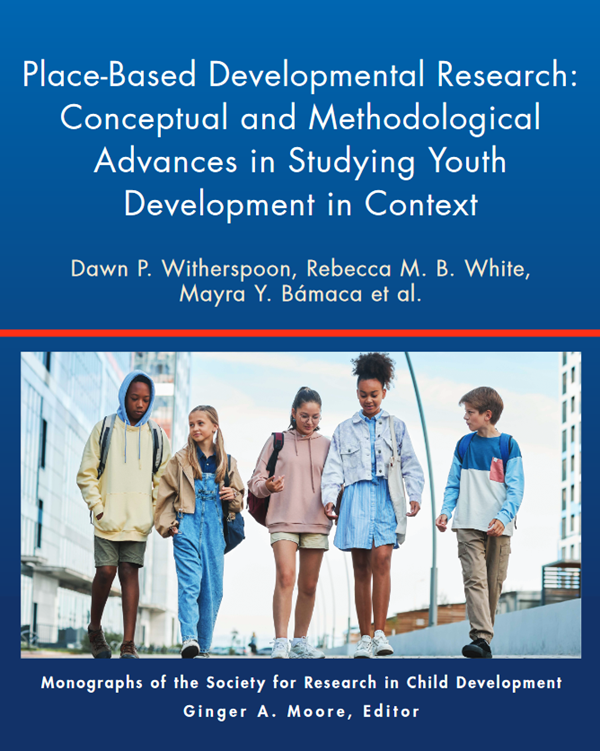Joint Attention in Human and Chimpanzee Infants in Varied Socio-Ecological Contexts.
IF 6.2
1区 心理学
Q1 PSYCHOLOGY, DEVELOPMENTAL
Monographs of the Society for Research in Child Development
Pub Date : 2021-12-01
DOI:10.1111/mono.12435
引用次数: 21
Abstract
Joint attention (JA) is an early manifestation of social cognition, commonly described as interactions in which an infant looks or gestures to an adult female to share attention about an object, within a positive emotional atmosphere. We label this description the JA phenotype. We argue that characterizing JA in this way reflects unexamined assumptions which are, in part, due to past developmental researchers' primary focus on western, middle-class infants and families. We describe a range of cultural variations in caregiving practices, socialization goals, and parenting ethnotheories as an essential initial step in viewing joint attention within inclusive and contextualized perspectives. We begin the process of conducting a decolonized study of JA by considering the core construct of joint attention (i.e., triadic connectedness) and adopting culturally inclusive definitions (labeled joint engagement [JE]). Our JE definitions allow for attention and engagement to be expressed in visual and tactile modalities (e.g., for infants experiencing distal or proximal caregiving), with various social partners (e.g., peers, older siblings, mothers), with a range of shared topics (e.g., representing diverse socialization goals, and socio-ecologies with and without toys), and with a range of emotional tone (e.g., for infants living in cultures valuing calmness and low arousal, and those valuing exuberance). Our definition of JE includes initiations from either partner (to include priorities for adult-led or child-led interactions). Our next foundational step is making an ecological commitment to naturalistic observations (Dahl, 2017, Child Dev Perspect, 11(2), 79-84): We measure JE while infants interact within their own physical and social ecologies. This commitment allows us to describe JE as it occurs in everyday contexts, without constraints imposed by researchers. Next, we sample multiple groups of infants drawn from diverse socio-ecological settings. Moreover, we include diverse samples of chimpanzee infants to compare with diverse samples of human infants, to investigate the extent to which JE is unique to humans, and to document diversity both within and between species. We sampled human infants living in three diverse settings. U.K. infants (n = 8) were from western, middle-class families living near universities in the south of England. Nso infants (n = 12) were from communities of subsistence farmers in Cameroon, Africa. Aka infants (n = 10) were from foraging communities in the tropical rain forests of Central African Republic, Africa. We coded behavioral details of JE from videotaped observations (taken between 2004 and 2010). JE occurred in the majority of coded intervals (Mdn = 68%), supporting a conclusion that JE is normative for human infants. The JA phenotype, in contrast, was infrequent, and significantly more common in the U.K. (Mdn = 10%) than the other groups (Mdn < 3%). We found significant within-species diversity in JE phenotypes (i.e., configurations of predominant forms of JE characteristics). We conclude that triadic connectedness is very common in human infants, but there is significant contextualization of behavioral forms of JE. We also studied chimpanzee infants living in diverse socio-ecologies. The PRI/Zoo chimpanzee infants (n = 7) were from captive, stable groups of mixed ages and sexes, and included 4 infants from the Chester Zoo, U.K. and 3 from the Primate Research Institute, Kyoto University, Japan. The Gombe chimpanzee infants (n = 12) were living in a dynamically changing, wild community in the Gombe National Park, Tanzania, Africa. Additionally, we include two Home chimpanzee infants who were reared from birth by a female scientist, in the combined U.S., middle-class contexts of home and university cognition laboratory. JE was coded from videotaped observations (taken between 1993 and 2006). JE occurred during the majority of coded intervals (Mdn = 64%), consistent with the position that JE is normative for chimpanzee infants. The JA phenotype, in contrast, was rare, but more commonly observed in the two Home chimpanzee infants (in 8% and 2% of intervals) than in other chimpanzee groups (Mdns = 0%). We found within-species diversity in the configurations comprising the JE phenotypes. We conclude that triadic connectedness is very common in chimpanzee infants, but behavioral forms of joint engagement are contextualized. We compared JE across species, and found no species-uniqueness in behavioral forms, JE characteristics, or JE phenotypes. Both human and chimpanzee infants develop contextualized social cognition. Within-species diversity is embraced when triadic connectedness is described with culturally inclusive definitions. In contrast, restricting definitions to the JA phenotype privileges a behavioral form most valued in western, middle-class socio-ecologies, irrespective of whether the interactions involve human or chimpanzee infants. Our study presents a model for how to decolonize an important topic in developmental psychology. Decolonization is accomplished by defining the phenomenon inclusively, embracing diversity in sampling, challenging claims of human-uniqueness, and having an ecological commitment to observe infant social cognition as it occurs within everyday socio-ecological contexts. It is essential that evolutionary and developmental theories of social cognition are re-built on more inclusive and decolonized empirical foundations.不同社会生态环境下人类和黑猩猩婴儿的共同注意。
共同注意(JA)是社会认知的一种早期表现,通常被描述为在积极的情绪氛围中,婴儿向成年女性看或做手势以分享对物体的关注的互动。我们将这种描述标记为JA表型。我们认为,以这种方式描述JA的特征反映了未经检验的假设,部分原因是由于过去的发育研究人员主要关注西方,中产阶级的婴儿和家庭。我们描述了在看护实践、社会化目标和养育民族理论方面的一系列文化差异,作为在包容性和情境化视角下观察共同关注的重要初始步骤。我们通过考虑共同注意的核心结构(即三联性)和采用文化包容性的定义(标记为联合参与[JE])开始对JA进行非殖民化研究。我们的JE定义允许以视觉和触觉方式表达注意力和参与(例如,对于经历远端或近端照顾的婴儿),与各种社会伙伴(例如,同伴,哥哥姐姐,母亲),一系列共享主题(例如,代表不同的社会化目标,有玩具和没有玩具的社会生态),以及一系列情感基调(例如,对于生活在重视平静和低唤醒的文化中的婴儿,以及那些重视旺盛的文化)。我们对乙脑的定义包括来自任何一方的发起(包括成人主导或儿童主导的互动的优先事项)。我们的下一个基本步骤是对自然观察做出生态承诺(Dahl, 2017, Child Dev perspectives, 11(2), 79-84):我们在婴儿在他们自己的身体和社会生态中相互作用时测量乙脑。这一承诺使我们能够描述在日常环境中发生的乙脑,而不受研究人员施加的限制。接下来,我们从不同的社会生态环境中抽取了多组婴儿。此外,我们将不同的黑猩猩婴儿样本与不同的人类婴儿样本进行比较,调查人类独有的乙脑程度,并记录物种内部和物种之间的多样性。我们对生活在三种不同环境中的人类婴儿进行了抽样。英国婴儿(n = 8)来自居住在英格兰南部大学附近的西方中产阶级家庭。Nso婴儿(n = 12)来自非洲喀麦隆的自给农民社区。阿卡幼崽(n = 10)来自非洲中非共和国热带雨林的觅食群落。我们从2004年至2010年的录像观察中对乙脑的行为细节进行了编码。脑炎发生在大多数编码间隔(Mdn = 68%),支持脑炎在人类婴儿中是规范的结论。相比之下,JA表型并不常见,在英国(Mdn = 10%)比其他组(Mdn < 3%)更常见。我们发现乙脑表型(即乙脑特征的主要形式的配置)在物种内具有显著的多样性。我们得出结论,三联性在人类婴儿中非常普遍,但在脑炎的行为形式中存在显著的情境化。我们还研究了生活在不同社会生态中的黑猩猩幼崽。PRI/Zoo黑猩猩幼崽(n = 7)来自混合年龄和性别的圈养稳定群体,其中4只来自英国切斯特动物园,3只来自日本京都大学灵长类动物研究所。12只贡贝黑猩猩幼崽生活在非洲坦桑尼亚贡贝国家公园一个动态变化的野生群落中。此外,我们还包括两个家庭黑猩猩婴儿,他们从出生起就由一位女科学家抚养,在美国家庭和大学认知实验室的中产阶级背景下。根据录像观察(1993年至2006年期间拍摄)对乙脑进行编码。大多数编码间隔(Mdn = 64%)发生了乙脑,这与乙脑在黑猩猩幼崽中具有规范性的观点一致。相比之下,JA表型是罕见的,但在两个家黑猩猩婴儿中(8%和2%的间隔)比在其他黑猩猩群体中更常见(Mdns = 0%)。我们发现在构成乙脑表型的构型中存在种内多样性。我们的结论是,三合一连接在黑猩猩婴儿中非常普遍,但联合参与的行为形式是情境化的。我们比较了不同物种的乙脑,发现在行为形式、乙脑特征或乙脑表型上没有物种独特性。人类和黑猩猩的婴儿都发展情境化社会认知。当用文化包容性定义来描述三元连通性时,物种内多样性就被接受了。相比之下,限制对JA表型的定义特权了西方中产阶级社会生态学最重视的一种行为形式,无论这种互动是否涉及人类或黑猩猩婴儿。 我们的研究为如何去殖民化发展心理学中的一个重要话题提供了一个模型。非殖民化是通过包容性地定义现象,接受采样的多样性,挑战人类独特性的主张,以及在日常社会生态背景下观察婴儿社会认知的生态承诺来实现的。必须在更具包容性和非殖民化的经验基础上重建社会认知的进化和发展理论。
本文章由计算机程序翻译,如有差异,请以英文原文为准。
求助全文
约1分钟内获得全文
求助全文
来源期刊

Monographs of the Society for Research in Child Development
PSYCHOLOGY, DEVELOPMENTAL-
CiteScore
16.30
自引率
0.00%
发文量
0
期刊介绍:
Since 1935, Monographs of the Society for Research in Child Development has been a platform for presenting in-depth research studies and significant findings in child development and related disciplines. Each issue features a single study or a collection of papers on a unified theme, often complemented by commentary and discussion. In alignment with all Society for Research in Child Development (SRCD) publications, the Monographs facilitate the exchange of data, techniques, research methods, and conclusions among development specialists across diverse disciplines. Subscribing to the Monographs series also includes a full subscription (6 issues) to Child Development, the flagship journal of the SRCD, and Child Development Perspectives, the newest journal from the SRCD.
 求助内容:
求助内容: 应助结果提醒方式:
应助结果提醒方式:


